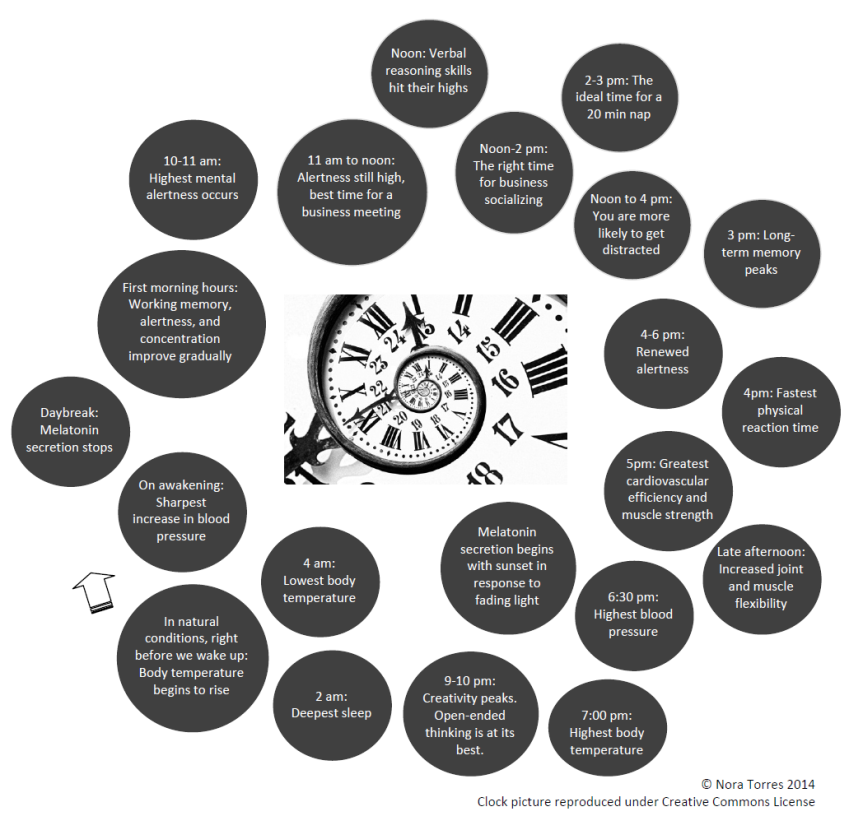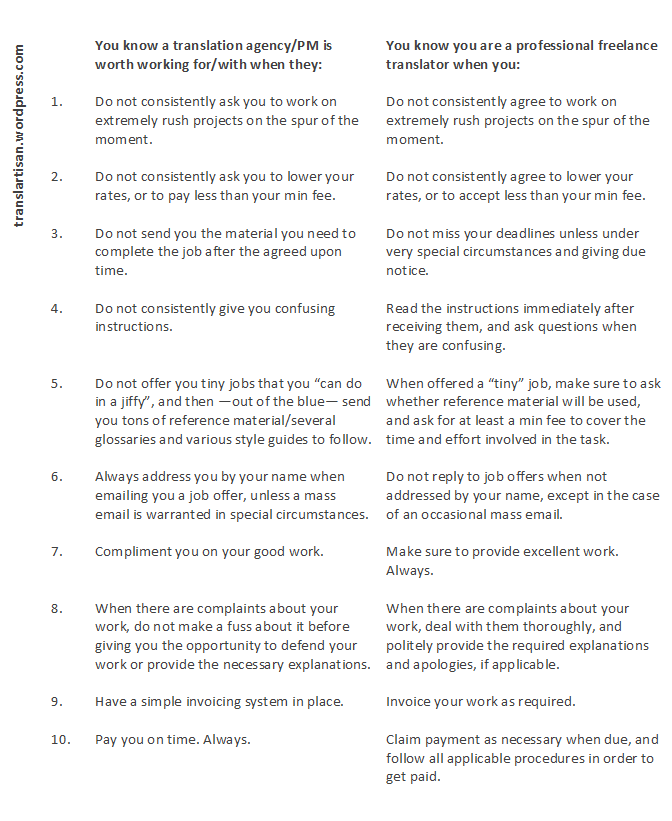Have you ever heard about such thing as the suprachiasmatic nucleus? The SCN, the human body’s master clock, lies deep inside the hypothalamus, behind the eyeballs, and controls circadian rhythms. In lay terms, the SCN instructs the pineal gland to increase the production of melatonin (a hormone that regulates the body’s natural sleep-wake cycle by promoting sleepiness and reducing motor activity) when daylight fades, and to decrease it when the SCN receives daylight information from the optic nerves. This process regulates many different body functions over a 24-hour cycle.
The guide below can help you plan your day following your circadian rhythm:
- In natural conditions, your body temperature begins to rise just before you wake up, and continues to rise until noon. The sharpest increase in your blood pressure occurs in the morning, on awakening. With daybreak, melatonin secretion is inhibited. All this prepares you to start your day off!
- Working memory (the system by which data input is brought into the brain, interpreted, and sorted), alertness, and concentration improve gradually during the first morning hours.
- Mid-morning is usually the time when your concentration, alertness, and working memory are at their best. Research has shown that 8 to 11 a.m. are the best hours to tackle the day’s toughest intellectual projects, with mental alertness peaking at about 10 to 11 a.m.
Tip: Use this period of time to take care of high-order problem solving and other intellectually challenging work, leaving relatively easier tasks for later.
- 11 a.m. to noon: Focus and concentration normally begin to decrease, but alertness remains high.
Tip: This would be a great time for a business meeting. With good part of the most challenging work for the day already done, you are still in a good position to make complex decisions and solve tricky problems.
- Verbal reasoning skills hit their highs at noon.
Tip: This would be the best time for an argument. Do you still have to make that phone call to claim a long-outstanding payment? Go for it at midday!
- From noon to about 2 p.m., cheerfulness is usually at its best, just right for business socializing.
Tip: If you wondered whether it would be better to discuss that collaboration agreement over a working breakfast or a business lunch, you now have the answer.
- From about 2 to 3 p.m., your metabolism slows down and your sleepiness increases, which makes this the ideal time for a short nap.
Tip: Taking a 20-minute ‘power nap’ at this time of the day can improve your alertness and motor skills.
- Long-term memory peaks at about 3 p.m.
Tip: This would be an excellent time to go over the glossary and reference material for an upcoming translation project or interpretation assignment.
- From 4 to 6 p.m., alertness gets a new boost.
Tip: You can plan to finish your important work for the day at this time. Alternatively or additionally, you can answer non-rush e-mails, do your billing, and schedule your next day.
- The period from about 3 to 7 p.m. is usually the best time for physical performance.
- Blood circulation, hand-eye coordination, reaction times, and muscle strength hit their highest point in this period.
Tip: Plan to play your favorite sport, have your workout session, or just go for a brisk walk at this time of the day, and you will get much better results. Keep in mind that:
- Fastest reaction time occurs at about 4 p.m.
- Greatest cardiovascular efficiency and muscle strength, at about 5 p.m.
- Joints and muscles are warmer and more flexible (reducing the risk of injury) in the late hours of the afternoon.
- Your blood pressure reaches its high at about 6:30 p.m.
- Your highest body temperature occurs at about 7:00 p.m.
Very important tip: Evenings are the ideal time for a glass of wine, as your liver is better able to metabolize alcohol at that time.
- Melatonin secretion begins with sunset, in response to fading light.
- You may be surprised to hear that, for most mortals, creativity peaks at about 9 to 10 p.m. When you start to get low on energy just before bedtime, your frontal cortex (part of the brain responsible for things such as attention, planning, and working memory) gets less involved in processing what is going on around you. Instead of concerning yourself with your current projects (that tight deadline that is driving you crazy, a challenging interpreting assignment scheduled for the next day), your brain is able to wander more freely, and think in non-linear ways.
Tip: Problems requiring open-ended thinking are best dealt with at this time.
- Deepest sleep occurs at about 2:00 a.m.
- Lowest body temperature, at about 4:30 a.m.
All this may vary, of course, based on your own chronotype and energy cycle (i.e., whether you are a morning or evening person (a “lark” or an “owl”), but most of us are right about the middle.
At this point, I know what you may be thinking— We do not always get to choose what time we do things. But having this knowledge can help you tune your schedule to the ticking of your internal clock as much as you can. I do hope you can give it a try and would love to hear your findings.

References:
Harriet Griffey: The Art of Concentration: Enhance focus, reduce stress and achieve more. Pan Macmillan, 2010.
Melatonin: A Closer Look, The American Heritage® Science Dictionary, Houghton Mifflin Company.
Sue Shellenbarger (for The Wall Street Journal, Work and Family Section): The Peak Time for Everything: Pack More in a Day By Matching Tasks To the Body’s Energy. Updated 09/26/2012, Accessed: 09/18/2014. http://online.wsj.com/news/articles/SB10000872396390444180004578018294057070544
Josie Padro (for alive Interactive): Your Body Clock. February-March 2014. Accessed 09/18/2014. http://interactive.alive.com/february-march-2014/your-body-clock/#
Stephanie Dutchen (for the U.S. Department of Health and Human Services, National Institutes of Health, National Institute of General Medical Sciences): A Light on Life’s Rhythms. Accessed 09/18/2014. http://publications.nigms.nih.gov/findings/sept11/lightliferhythms.asp
Bob Condor (for The Chicago Tribune): The Body Clock. Published 10/31/1994, Accessed 10/02/2014. http://articles.chicagotribune.com/1994-10-31/features/9410310028_1_body-clock-circadian-chronobiology
Kayte Nunn (for The Sydney Morning Herald): Reset your body clock. Published 06/02/2012, Accessed 10/02/2014. http://www.smh.com.au/lifestyle/diet-and-fitness/reset-your-body-clock-20120206-1r0h6.html#ixzz3Ez0sM1qw
Tanner Christensen (for Creative Something): Why You’re More Creative At Night And How To Reproduce The Effect. Posted 09/07/2013, Accessed 10/02/2014. http://creativesomething.net/post/54997033332/why-youre-more-creative-at-night-and-how-to-reproduce
Belle Beth Cooper (for Buffer): Why Most Olympic Records are Broken In The Afternoon: Your Body’s Best Time For Everything. Posted 07/18/2013, Accessed 10/03/2014. http://blog.bufferapp.com/your-bodys-best-time-for-everything-how-to-eat-sleep-and-work-more-efficiently
This article was originally posted on Alberoni Translations’ blog, Carol’s Adventures in Translation, on October 14, 2014:

